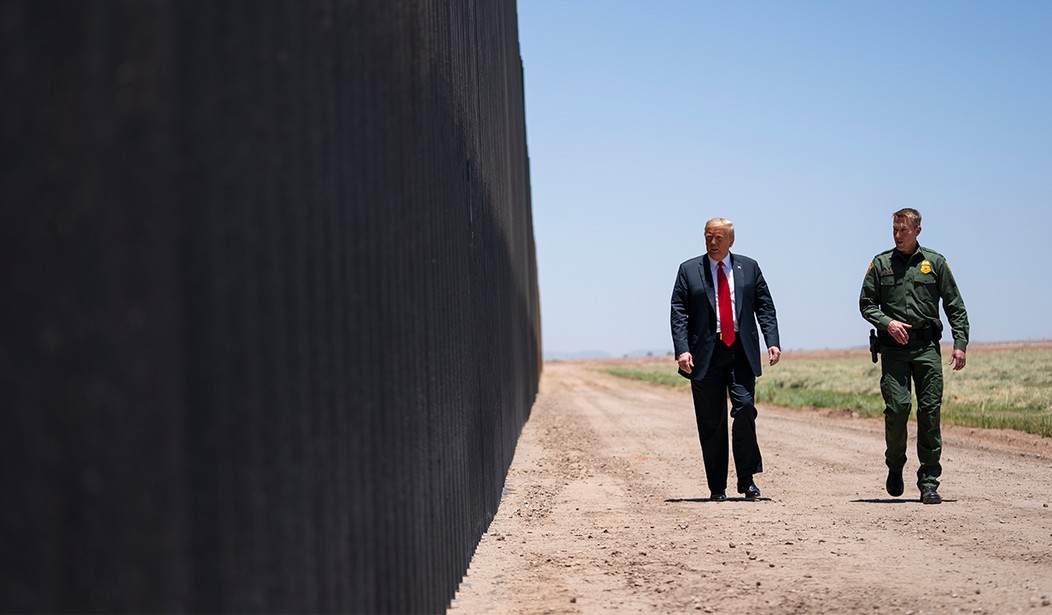On Friday, United States Customs and Border Protection released a statement confirming that they will move forward with the construction of 20 miles of the border wall, despite the Biden administration’s calls to thwart the project. For fiscal year 2019, Congress allocated $1.375 billion in funding “for the construction of primary pedestrian fencing, including levee pedestrian fencing, in the Rio Grande Valley,” and $190 million of that funding remains. Customs and Border Protection wrote:
Today, the Department of Homeland Security (DHS) authorized U.S. Customs and Border Protection (CBP) to move forward with the planning and execution of up to approximately 20 miles of border barrier system, with steel bollard panels placed in U.S. Border Patrol’s (USBP) Rio Grande Valley (RGV) Sector, as mandated by the DHS Fiscal Year (FY) 2019 border barrier appropriation. This project is consistent with the Department of Homeland Security’s (DHS) plan to fulfill the requirements of President Biden’s Proclamation, which ended the diversion of funds for border wall from military projects or other sources. A substantial portion of unobligated funds that had been diverted from the Department of Defense have already been returned to their original sources. DHS is legally mandated to use the remaining FY2019 funds for their appropriated purpose.
The administration is legally bound to use the funding as appropriated, which includes the construction elements of the border wall’s design. The statement said:
As required by DHS’s FY 2019 appropriation, CBP will be using 18-foot steel bollard fence panels placed in removable concrete jersey barriers, as the steel bollard design remains the most operationally effective design and has been tested and evaluated over the last several years.
Despite being legally bound to the fiscal allocation and design, the Department of Homeland Security and the White House have continuously called on Congress to cancel the funding. President Joe Biden issued a proclamation on his first day in office, calling the previously declared national emergency at the southern border, “unwarranted,” and the use of funds to build barriers on the US-Mexico border, “a waste of money.” The proclamation ended the emergency, halted the construction of the border wall, and required a plan to redirect funds and repurpose contracts.
Biden wrote:
Consequently, the declaration of a national emergency at the southern border, which allowed for the diversion of taxpayer funds to build the wall, is considered unnecessary. The policy now is to prevent further diversion of taxpayer money for border wall construction.
Since Biden’s tenure began, “a substantial portion of unobligated funds that had been diverted from the Department of Defense (DoD) have already been returned to their original sources,” per the Border Protection statement. However, the Biden administration has not been successful in canceling congressionally appropriated funding. In June 2021, the White House released a Fact Sheet outlining the plans put forward by DHS and DoD while re-issuing the administration’s call to Congress, writing:
Additionally, the Administration is reiterating its call for Congress to cancel funds it previously appropriated for border barrier projects so that these resources can instead be used for modern, effective border management measures to improve safety and security.
On Friday, the CBP statement reiterated the appeal to Congress to stop the funding:
The Administration continues to call on Congress to cancel or reappropriate remaining border barrier funding and instead fund smarter border security measures, like border technology and modernization of land ports of entry, that are proven to be more effective at improving safety and security at the border. Until and unless Congress cancels these funds, the law requires DHS to use the funds consistent with their appropriated purpose. DHS first pursued other priority projects in RGV with the appropriated FY 2019 funding, including life, safety, environmental, and other remediation measures, system attributes for existing barrier, and environmental mitigation projects.
Last July, the Biden administration authorized the expansion of the wall in an open area in Yuma, Ariz., near Morelos Dam. The area had become a high-traffic location for illegal crossings, with risks of falling and drowning to both illegal immigrants and Border Patrol personnel in a section of the Colorado River. The project had previously been funded by the DoD diversion that Biden ordered to be canceled.
The DHS press release says:
Secretary of Homeland Security Alejandro N. Mayorkas has authorized U.S. Customs and Border Protection (CBP) to execute the Yuma Morelos Dam Project to close four gaps located within an incomplete border barrier project near the Morelos Dam in the U.S. Border Patrol’s Yuma Sector. These projects address operational impacts, as well as immediate life and safety risks, and will be funded with DHS’s Fiscal Year 2021 appropriations.
The gaps are located within the former Yuma 6 project area, a border barrier project that was previously funded by the Department of Defense’s (DoD) military construction appropriation pursuant to 10 U.S.C. § 2808.
Friday’s statement said this project would also be moving forward:
In addition, DHS authorized CBP to move forward with the Yuma Andrade and El Centro Calexico Fence Replacement Projects to mitigate immediate life, safety and operational risks to the local community, migrants, and Border Patrol agents in the area. Both projects will replace dilapidated segments of legacy fencing that presently create safety and security concerns for USBP agents, migrants, and the surrounding community. These replacement projects, similar to previously approved projects, prioritizes the completion of activities and projects needed to address life, safety and operational risks – including the safety and security of individuals, Border Patrol agents, migrants, and nearby communities.
The Biden Administration’s Handling of the Border Crisis: Contradictions and Concessions
Since it’s clear that the Biden administration does not want to build a border wall, what are their priorities? The administration continues to outline a preference for initiatives related to non-barrier border security, writing on Friday:
DHS continues to prioritize fence replacement and gap closure projects and to prioritize non-barrier solutions, including deploying technology and other system elements in locations where barrier has been constructed.
In the past, these non-barrier solutions have included the White House focusing on “addressing the root causes of migration, driving 21st-century technological solutions for border management, and giving people options to apply for asylum and other legal pathways in their home country.”
As an advocate specifically for the latter suggestion, a policy I call “Consulates Not Cartels,” this author notes that the administration has made no policies that actually do what they suggest. Instead, they have created an immigration parole program directed at the specific nationalities of Venezuelans, Cubans, Nicaraguans, and Haitians. Of those nations that have embassies, none of them are available to remotely apply for asylum. In fact, nowhere in the immigration parole program is an asylum application included whatsoever. Further, it still requires people to appear at a port of entry to then be considered… which is no different than the current in-use process.
When a beneficiary arrives a port of entry, CBP will inspect them and consider them for a grant of discretionary parole on a case-by-case basis.
The basis of this program is highly questionable, as I previously reported that the administration sent a memo out hours before the expiration of Title 42 and was subsequently sued by Florida, with a judge issuing an injunction:
Late on Thursday, hours before Title 42 was set to expire, a federal judge in Florida issued a ruling blocking certain aspects of the Immigration Parole program. An injunction hearing is scheduled in two weeks. This lawsuit was filed by Florida Governor Ron DeSantis and Florida Attorney General Ashley Moody on Thursday.
Border Patrol issued a memo on Wednesday with guidance for “parole with conditions” as a way to address potential overcrowding in detention facilities. Immigration parole is typically granted on a case-by-case basis for reasons of significant public interest or humanitarian concerns. The program requires financial sponsors, background checks, the ability to pay for travel, and health requirements. Normally, the process takes 60-120 days, but it can be expedited in certain circumstances.
While using the parole program for overcrowding purposes is not consistent with its usual operation, there is no specific definition of “significant public benefit” in the statutes or regulations.
Furthermore, it’s important to note that the parole program was never intended to serve as an asylum program. If individuals are granted immigration parole, they still need to apply for asylum separately. This nuance explains why you see sensationalized headlines claiming that people are not given asylum or court dates. That’s because it’s not an asylum application process.
In conclusion, the narrowly aimed parole program patently does not “give people options to apply for asylum in their home country,” and doesn’t even tell them if they will be admitted or not, just instructs them to show up at a port of entry, and then… to enter without ever applying for asylum. To be clear: that is neither “asylum application” nor “from their home country,” so the Biden administration did literally none of that.
It’s clear the Biden administration is eating crow on the border crisis they claimed on day one didn’t exist while they battled in courts to far extend the use of Trump-era Title 42, which, by the way, is the exact opposite policy of “giving people options to apply for asylum,” and now they will concede again and continue another Trump administration policy and “build the wall.”












Join the conversation as a VIP Member